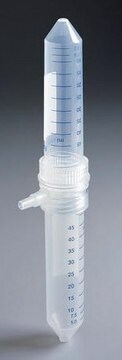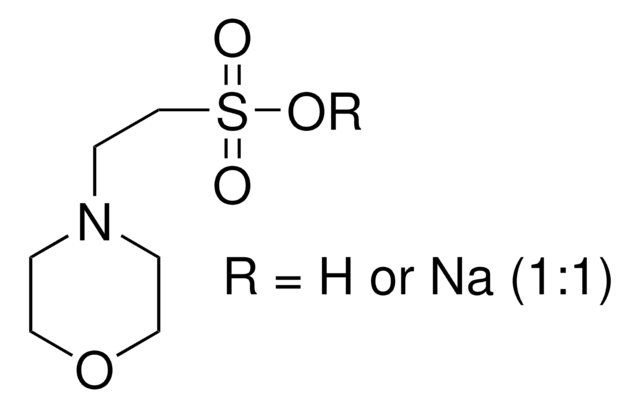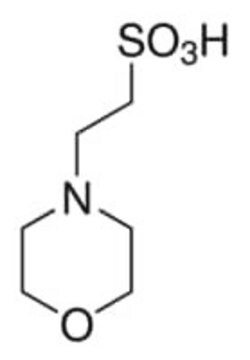69889
MES monohydrate
BioUltra, for molecular biology, ≥99.5% (T)
Sinonimo/i:
2-Morpholinoethanesulfonic acid hydrate,, 2-morpholin-4-ylethanesulfonic acid;hydrate, 2-(N-Morpholino)ethanesulfonic acid, 4-Morpholineethanesulfonic acid monohydrate
About This Item
Prodotti consigliati
Grado
Molecular Biology
for molecular biology
Livello qualitativo
Nome Commerciale
BioUltra
Saggio
≥99.5% (T)
Stato
powder or crystals
Impurezze
DNases, none detected
Insoluble matter, passes filter test
Phosphatases, none detected
Proteases, none detected
RNases, none detected
Residuo alla calcinazione (900 °C)
≤0.05% (as SO4)
pH
2.5-4.0 (25 °C, 0.5 M in H2O)
Intervallo di pH utile
5.5-6.7
pKa (25 °C)
6.1
Punto di fusione
>300 °C (lit.)
Solubilità
H2O: 0.5 M at 20 °C, clear, colorless
Densità
10.66 g/mL
Anioni in tracce
chloride (Cl-): ≤50 mg/kg
sulfate (SO42-): ≤50 mg/kg
Cationi in tracce
Al: ≤5 mg/kg
As: ≤0.1 mg/kg
Ba: ≤5 mg/kg
Bi: ≤5 mg/kg
Ca: ≤20 mg/kg
Cd: ≤5 mg/kg
Co: ≤5 mg/kg
Cr: ≤5 mg/kg
Cu: ≤5 mg/kg
Fe: ≤5 mg/kg
K: ≤50 mg/kg
Li: ≤5 mg/kg
Mg: ≤5 mg/kg
Mn: ≤5 mg/kg
Mo: ≤5 mg/kg
Na: ≤50 mg/kg
Ni: ≤5 mg/kg
Pb: ≤5 mg/kg
Sr: ≤5 mg/kg
Zn: ≤5 mg/kg
λ
0.5 M in H2O
Stringa SMILE
O.OS(=O)(=O)CCN1CCOCC1
Assorbanza UV
λ: 260 nm Amax: 0.025
λ: 280 nm Amax: 0.020
Compatibilità
suitable for DNase I test
suitable for Western blot
suitable for molecular biology
applicazioni
clinical research
diagnostic assay manufacturing
life science and biopharma
Attività estranea
DNase, none detected
NICKase, none detected
RNase, none detected
protease, none detected
InChI
1S/C6H13NO4S.H2O/c8-12(9,10)6-3-7-1-4-11-5-2-7;/h1-6H2,(H,8,9,10);1H2
MIIIXQJBDGSIKL-UHFFFAOYSA-N
Cerchi prodotti simili? Visita Guida al confronto tra prodotti
Descrizione generale
Applicazioni
- In the preparation of a solution used for the suspension and dilution of protoplasts to measure the density and number of protoplasts using a haemocytometer
- As a component of Murashige and Skoog basal salt media
- In the preparation of total ionic strength adjustment buffer (TISAB)
- as a constituent in mobile phase solutions employed for the analysis of high molecular weight species and charge-related variants of biopharmaceutical proteins through SEC, HIC, and IEX chromatographic techniques
Caratteristiche e vantaggi
- Suitable as a Buffer component, for Electrophoresis and Molecular Biology
- Effective Buffering from pH 2.5-4.0 (25 °C, 0.5 M in H2O) with a pKa of 6.1 (25 °C)
- Free from DNase, NICKase, RNase, and Protease
Nota sulla preparazione
Altre note
Sterilization: Sterilization should be by filteration through 0.2 uM filters. Autoclaving is not recommended by any sulfonic acid buffers. If buffers must be nuclease-free, it is best to treat the water, and then add the buffer solids after autoclaving. When MES solutions are autoclaved, they turn yellow (although pH does not change measurably. The identity of the yellow breakdown product is unknown.
Codice della classe di stoccaggio
11 - Combustible Solids
Classe di pericolosità dell'acqua (WGK)
WGK 1
Dispositivi di protezione individuale
dust mask type N95 (US), Eyeshields, Gloves
Scegli una delle versioni più recenti:
Possiedi già questo prodotto?
I documenti relativi ai prodotti acquistati recentemente sono disponibili nell’Archivio dei documenti.
I clienti hanno visto anche
Il team dei nostri ricercatori vanta grande esperienza in tutte le aree della ricerca quali Life Science, scienza dei materiali, sintesi chimica, cromatografia, discipline analitiche, ecc..
Contatta l'Assistenza Tecnica.







